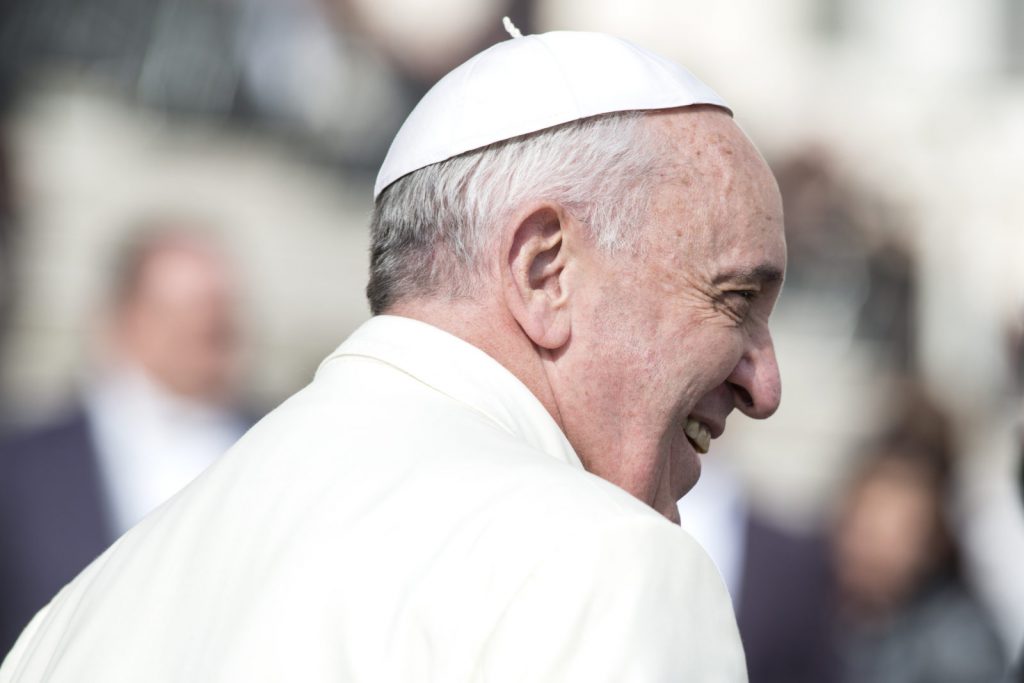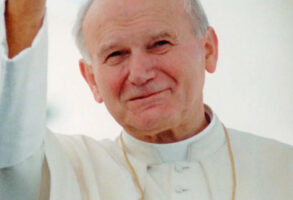
Published April 8, 2016
Weighing in at a gargantuan 261 pages, Amoris Laetitia (“The Joy of Love”) is, by my quick reckoning, the longest such document in the history of the papal magisterium, and by a good 10 percent or more. Its sheer size suggests the wisdom — although probably the futility, too — of Pope Francis’s plea that his apostolic exhortation “on love in the family” be read “patiently and carefully,” piece by piece, and then pondered as a whole.
The futility comes from the fact that various pre-exhortation Catholic spin machines have set a context for the reception of Amoris Laetitia that the world media will find irresistible, by focusing almost exclusive attention on the question of whether the pope would endorse one or other of Walter Cardinal Kasper’s proposals for admitting divorced and civilly remarried Catholics to holy communion (quick preview: Francis doesn’t). So look in the early going for a vast, global argument over whether a “door has been opened” or a “first step taken” to vindicating Kasper. Those who will say that Kasper has not been vindicated seem to me to have the better of the argument, on a close reading of the text of the exhortation. But that won’t prevent others, including German-speaking bishops and theologians who don’t seem capable of recognizing that their proposals were rejected by two synods of bishops, from claiming victory.
The other problem with the Pope’s plea for patience and care in reading Amoris Laetitia is that most Catholics (not to mention others) are simply not going to wade through a text of this length. And that is a shame, because the exhortation says many important things about love, marriage, the family, and the current cultural crisis of a world in which the imperial autonomous Self is running roughshod over just about everything, leaving a lot of human unhappiness in its wake.
Thus it might be a useful orientation for those who are going to take a cut at reading this vast, sprawling text to highlight some of what impress me as the exhortation’s most striking arguments — which may also serve as a mini-summary for those who have neither the time nor the inclination to read Amoris Laetitia (hereafter, AL) in full.
THE BIBLE SETS THE STAGE
At last October’s second synod on the family, the working document prepared by the synod office was severely criticized for beginning with some second-rate sociology rather than with the Word of God. Pope Francis evidently heard that criticism, for AL begins with a rich reflection on the Bible, which, as the Pope says, “is full of families, births, love stories, and family crises.” Francis then speaks movingly of “the majestic early chapters of Genesis,” which “present the human couple in its deepest reality.” Which is to say, the Biblical story of Adam and Eve is not a pious myth with no relevance for the 21st century; it speaks a truth about our being made male and female, and about the complementarity built into our difference, that is ageless and enduring. Moreover, Francis reminds us (following John Paul II), “the couple that loves and begets life is a true, living icon . . . capable of revealing God the Creator and Savior.” This even sheds light on that most unfathomable of Christian mysteries, the Holy Trinity, for “the couple’s fruitful relationship becomes an image for understanding and describing the mystery of God himself. . . . The triune God is a communion of love, and the family is its living reflection.”
Francis goes on to celebrate the Bible’s speaking of “the gift of children” and shows how, in primitive Christianity, the family was thought of as the “domestic Church, a setting for the Eucharist, the presence of Christ seated at the table.” But the Bible also speaks of the pain and suffering involved in family life, which is, like many other sorrows in the human condition, the result of the will to power run amok. Those biblical accounts of family struggle help us to understand something important: that “the word of God is not a series of abstract ideas but rather a source of comfort and companionship for every family that experiences difficulties or suffering.” If 21st-century Christians can learn to see the world through a lens ground by Biblical faith, they will see the truth about love, marriage, and the family clearly: that despite our tendency to make a mess of things, families are called to “become a communion of persons in the image of the union of the Father, the Son, and the Holy Spirit.” Then Christians can live in the sure confidence that the end of their journey is that Kingdom where God “will wipe away every tear from their eyes, and death shall be no more, neither shall there be mourning nor crying nor pain anymore” (Rev. 21:4).
THE CONTEMPORARY CRISIS OF MARRIAGE AND THE FAMILY
Francis’s catalogue of the cultural factors gnawing away at marriage and the family is comprehensive and, it seems to me, acute. It includes “extreme individualism,” the “pace of life” that militates against decisions for permanent relationships, and the mantra of “choice” as the highest of human goods, all of which lead to “an inability to give oneself generously to others.” Confused ideas of freedom – “that each individual can act arbitrarily, as if there were no truths, values, and principles to provide guidance, and everything [is] possible and permissible” – intensify the crisis.
The Pope cautions against a Church “on the defensive, wasting pastoral energy on denouncing a decadent world without being proactive in proposing ways of finding true happiness.” Which is true enough, in those sectors of the Church, rare in my experience, where such doomsaying is the plat du jour. But then Francis himself goes on to deplore the “narcissism” that “makes people incapable of looking beyond themselves,” which is surely one major factor in the contemporary meltdown of marriage and the family. So, too, he writes, is that “great poverty of contemporary culture” which is “loneliness, arising from the absence of God in a person’s life and the fragility of relationships.”
AL then discusses the challenges posed to marriage and the family by economic dislocation, migration, human trafficking, the abuse of women, the sexual abuse of children, dire poverty, a rapidly evolving global economy, and an “ideology of gender.” But over and beyond those undoubted scourges is “a failure to realize that only the exclusive and indissoluble union between a man and a woman has a plenary role to play in society as a stable commitment that bears fruit in new life.” And that ignorance is leading to “a legal deconstruction of the family, tending to adopt models based almost exclusively on the autonomy of the individual will.” (Justice Anthony Kennedy, please call the Vatican.)
Yet the bad news is not all the news there is. Thus Francis concludes this section of AL with a prayer: “I thank God that many families, which are far from considering themselves perfect, live in love, fulfill their calling, and keep moving forward, even if they may fall many times along the way.”
CHRIST AND THE FAMILY
The Christian family, the pope writes, “can be fully understood only in the light of the Father’s infinite love revealed in Christ, who gave himself for our sake and who continues to live in our midst . . . at the heart of so many love stories.” This means that the Christian family is, was, and always will be countercultural: not to be different for difference’s sake, but to offer a model of a nobler way of living. That way is rooted in God’s original plan for humanity and reaches its perfection in “marriage and the family . . . redeemed by Christ and restored in the image of the Holy Trinity, the mystery from which all true love flows.”
That is why the Catholic Church believes and teaches — and will always believe and teach — that marriage is indissoluble, sacramental, and ordered to both the sanctification of the spouses and the begetting and rearing of children. Francis applauds Blessed Paul VI for Humanae Vitae, the 1968 encyclical on the morally appropriate means of regulating fertility, recommends Saint John Paul II’s theology of the body for its “vision of the vocation of men and women to love,” and notes that Benedict XVI found in the family that place where “we learn the experience of the common good.”
Thus Christians must always propose marriage as something far more, and far deeper, than “a social convention, an empty ritual, or merely the outward sign of a commitment.” Marriage is a “vocation, inasmuch as it is a response to a specific call to experience conjugal love as an imperfect sign of the love between Christ and the Church.” So the decision to marry, like the decision to seek ordination or enter consecrated religious life, “ought to be the fruit of a process of vocational discernment.” That, in turn, means that marriage preparation ought to be one crucial instrument in the Church’s work of evangelization, as pastors help those preparing for marriage to enter into the “nuptial mystery.”
AL’s celebration of the gift of children also includes what may be Pope Francis’s most ringing affirmation of the right to life of the unborn: “I feel it urgent to state that, if the family is the sanctuary of life, the place where life is conceived and cared for, it is a horrendous contradiction when it becomes a place where life is rejected and destroyed. So great is the value of a human life, and so inalienable the right to life of an innocent child growing in its mother’s womb, that no alleged right to one’s own body can justify a decision to terminate that life, which is an end in itself and which can never be considered the ‘property’ of another human being.”
The pope then explicates this Christ-centered understanding of love in marriage in an entire chapter given to a sentence-by-sentence exegesis of Saint Paul’s hymn to love as the “more excellent way” in I Corinthians 13:4-7. After looking at how each of the qualities that Paul ascribes to genuine love as “the greatest of these” ought to shape a marriage, Francis notes that the “mystery of marriage” is that “God makes of the two spouses one single existence.” There, husband and wife, through conjugal love, participate in what Thomas Aquinas called “the greatest form of friendship,” in which passion is “always directed to an ever more stable and intense union,” and in which sex is understood as “an interpersonal language in which the other is taken seriously, in his or her sacred and inviolable dignity.” As for those young people scared by the idea of permanent commitment, the Pope offers this counsel: Marriage is “the means to ensure that [your] love will truly grow and endure.”
THE FRUITFULNESS OF MARRIAGE, THE PLAGUE OF DIVORCE, AND EDUCATION
AL celebrates the procreative character of marriage and the family and discusses in a touching way how adoption expands the fruitfulness of marriage. The pope who not infrequently cites his grandmother in his homilies also lifts up the beauty of the generationally extended family. The “family,” in Francis’s view, is a network of relationships, in which the young and the elderly have responsibilities toward each other, as do brothers and sisters.
Beyond marriage preparation, AL calls for the Church to accompany young married couples in their first years of marriage, as they begin their families, and as they experience crises. Marital crisis too easily leads to marital breakdown; thus the pope urges all to see that “each crisis has a lesson to teach us; we need to learn to listen for it with the ear of the heart.”
The Church’s care must also extend to those who have been abandoned by their spouse, who are separated, or who are divorced, and refers pastors to the revised procedures for determining whether a first marriage did not in fact exist (usually referred to as an “annulment”). But there is no suggestion here that divorce is a minor matter, not least because of its bad effects on children. Rather, the pope writes, “divorce is an evil and the increasing number of divorces is very troubling. Hence our most important pastoral task with regard to families is to strengthen their love, helping to heal wounds, and working to prevent the spread of this drama of our times.”
AL offers a strong affirmation of “sex education,” but makes clear that this is not a sub-discipline of plumbing. Rather, education in human sexuality ought to take place “within the broader framework of an education for love, for mutual self-giving.” How this might be done in, say, American public schools will be an interesting topic of discussion down the line.
PASTORAL ACCOMPANIMENT IN DIFFICULT CIRCUMSTANCES
The eighth chapter of AL, which takes up the question of the Church’s care for those in broken marriages and those who have been divorced and civilly remarried, will doubtless be the focus of extended discussion. That this will happen is due in no small part to the hijacking of the synods of 2014 and 2015 by northern European bishops who seem to think that a radical change in the Church’s teaching on the indissolubility of marriage and on worthiness to receive holy communion is a magic solution to the death of their local Churches, where regular Mass attendance is now in the mid single digits.
As this discussion unfolds, it will be important to keep in mind that AL cites the Final Report of the 2015 Synod on the key point: that all pastoral accompaniment of the divorced and civilly remarried, including discernment of ways in which they can be better integrated into the life of the Catholic community, is to take place “according to the teaching of the Church” — which means, in this context, the Church’s settled teaching on indissolubility and on worthiness to receive holy communion. It will also be important to keep in mind, as this discussion continues, that the kind of pastoral accompaniment and discernment so strongly urged by Pope Francis is in fact what goes on in the Catholic parishes and dioceses with which I’m most familiar. There are exceptions, I’m sure, and I’ve heard my share of horror stories about unfeeling and incompetent priests — and they are horrific, and disgraceful. But the priests and bishops I know bend every possible effort to be sensitive to difficult situations, and to see how they might be resolved in ways that serve both mercy and truth.
Failure is not something new in the Church; failure has been part of the Christian story from the beginning. If the Church has failed to make sufficiently clear that we are all sinners, that we all live by the divine mercy, and that, at the end, we have only the merits of Christ to plead on our behalf, then it is good to be reminded, as Pope Francis so regularly reminds us, of these truths. At the same time, the pope of mercy is the pope of a “Church permanently in mission,” as he put it in the apostolic exhortation Evangelii Gaudium. And the most vital, evangelically assertive parts of the world Church today are those that have neither abandoned mercy in the name of abstract truth, nor abandoned the patrimony of truth bequeathed to the Church by Christ for the sake of a thin notion of mercy that is more sentimental than divine. Truth and mercy always go together. Pope Francis knows that. And the discussion of AL’s proposals on dealing with the most complex situations will be well served if the discussants keep that indissoluble dyad in mind.
QUESTIONS FOR THE FUTURE
At the very outset of this lengthy document, Pope Francis writes that it is not his purpose to settle everything, and that there is a “need for continued open discussion of a number of doctrinal, moral, spiritual, and pastoral questions.”
Among them might be the question of how the unity of the Church coheres with the proposal that “each country or region . . . can seek solutions better suited to its culture and sensitive to its traditions and local needs.” There’s an obvious truth in that; but there is also truth in the observation, made during the 2015 synod, that what is a grave sin in Poland cannot be a source of grace on the German side of the Polish–German border. What, then, are the boundaries of the “inculturation” of truth and mercy, such that the Church remains the Church, and faithful to Christ, wherever she is?
Then there is AL’s regular use of the term “ideal” to describe the Church’s full understanding of marriage. Here, too, is an obvious truth. But one wonders whether it wouldn’t be better to describe that “ideal” as the “full” truth of marriage to which we aspire in our lives. Part of the genius of John Paul II with young people was that he knew the young want to be challenged to lead lives of heroic virtue — just as he knew that no one always lives that “ideal.” That is why he stressed the importance of confession and the sacrament of reconciliation as a means to keep seeking noble and heroic goals.
Amoris Laetitia will also keep the theologians busy, analyzing its moral theology and its reading of Church tradition. All of this churning, I think we must believe, will finally work out to the good of the Church and the advance of its mission of evangelization and service — and to the good of a world that badly needs to hear the truths the pope teaches. But that will happen only if AL is read in full, with the care and patience its author requests, and with these striking two sentences from the document as the framework for the ongoing discussion: “To show understanding in the face of exceptional situations never implies dimming the light of the fuller ideal, or proposing less than what Jesus offers to human beings. Today, more important than the pastoral care of failures is the pastoral effort to strengthen marriages and thus to prevent their breakdown.”
– George Weigel is Distinguished Senior Fellow of Washington’s Ethics and Public Policy Center, where he holds the William E. Simon Chair in Catholic Studies.






